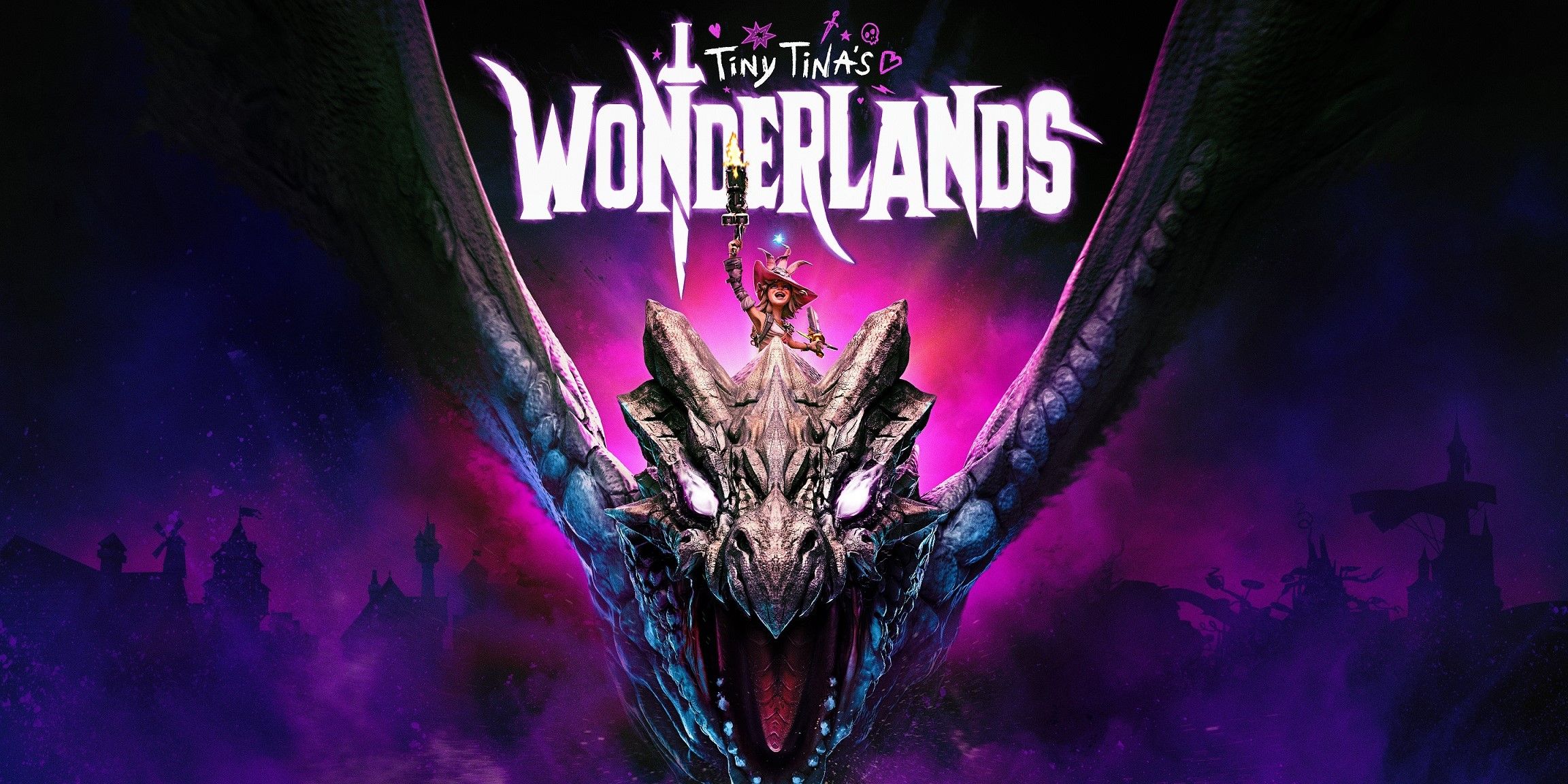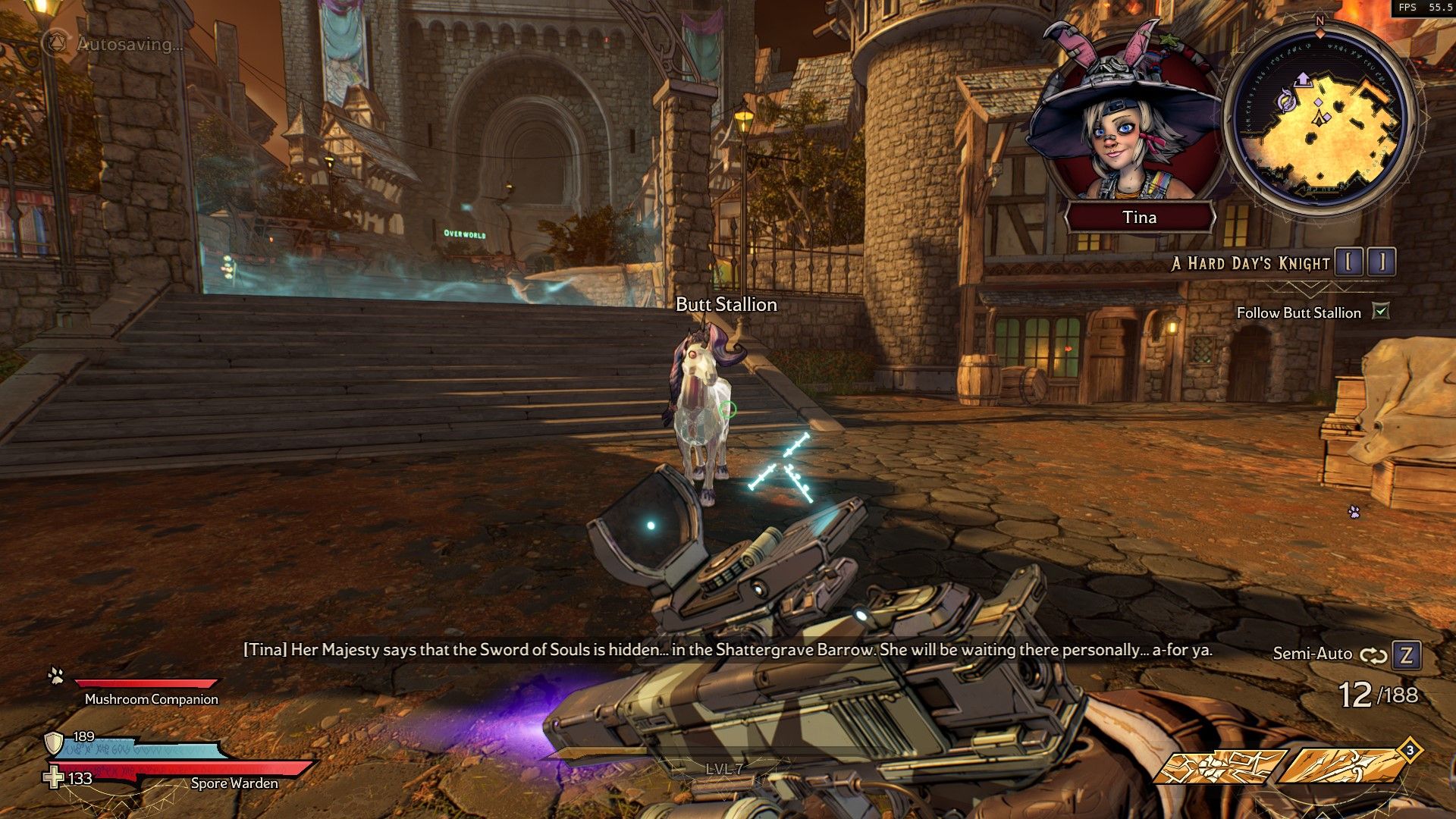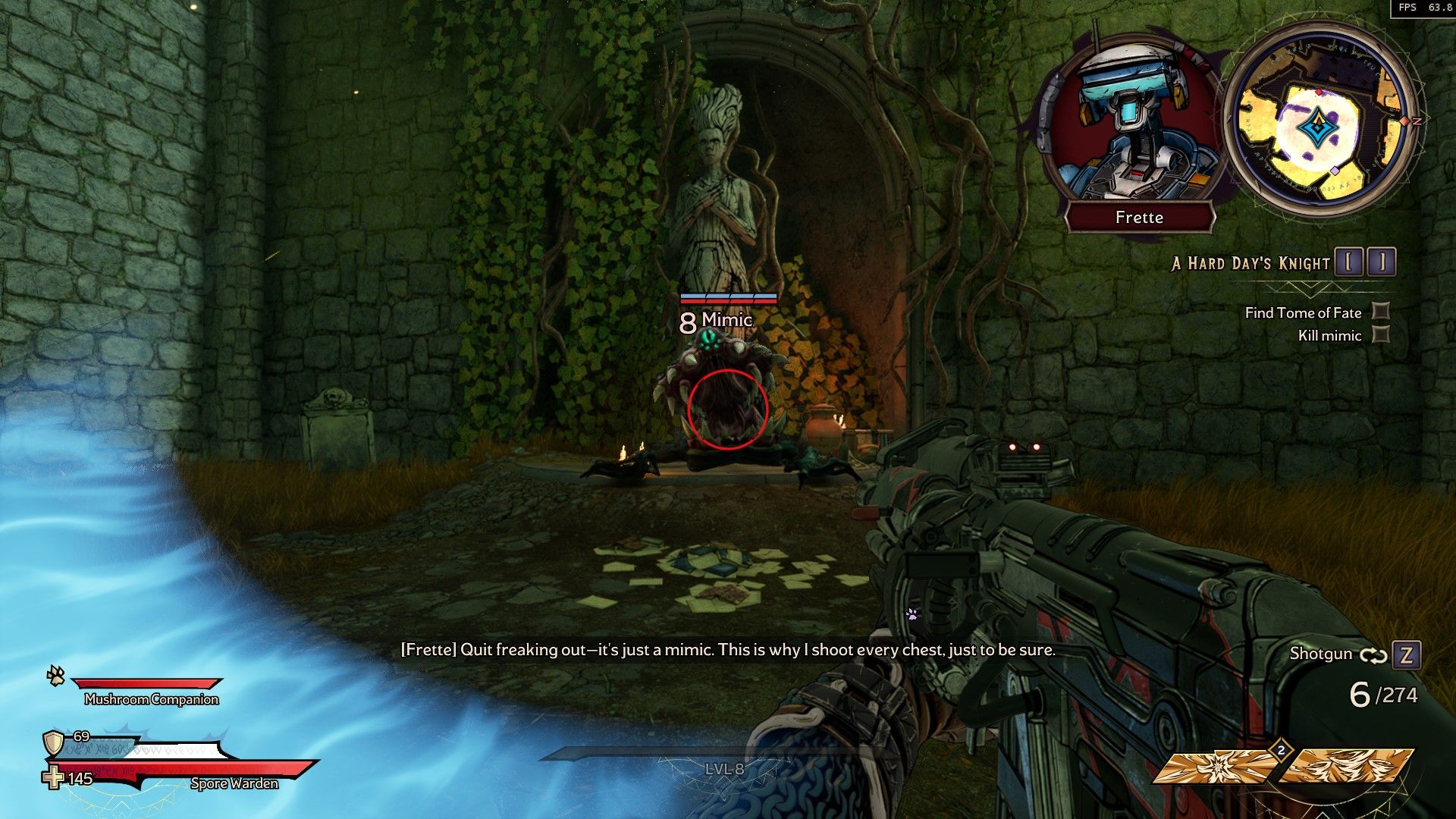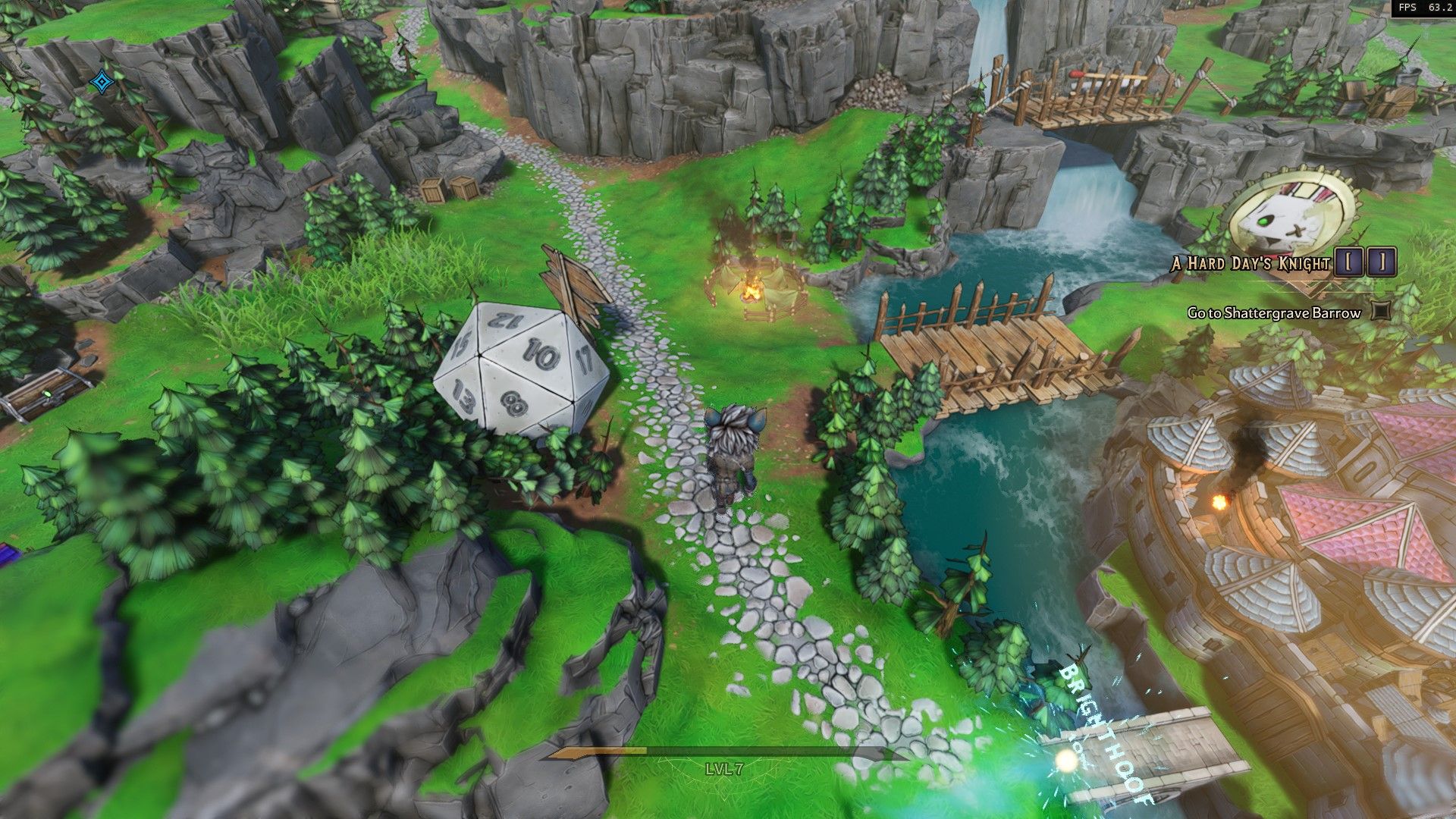Tiny Tina’s Wonderlands is essentially a full-length version of the concept introduced in the Borderlands 2 DLC Tiny Tina’s Assault on Dragon Keep where the vault hunters of that installment got to join the titular character for a campaign in an in-universe riff on Dungeons & Dragons called Bunkers & Badasses. The whole of Wonderlands feels like a fleshed-out version of what was introduced there both in narrative and gameplay, and it also benefits heavily from the massive surge that D&D’s popularity has enjoyed in the years since.
Tiny Tina’s story opens up at the end of another. In this tale, three heroes referred to as Fatemakers find themselves facing off with their campaign’s final boss, the Dragon Lord, at the top of a death pyramid. Through some well timed DM intervention, they are assisted in their fight by the radiant Queen Butt Stallion who uses the Sword of Souls to seal away the Dragon Lord. During this scene the player, or Newbie which they are referred to as, is introduced to the other two players at the table, the overconfident but well-meaning Valentine and the murder hungry, rules lawyer Frette. After a time skip and some bickering with Tina, it is determined that only the Newbie will be allowed to have a character in the trio’s new campaign with the other two’s new jobs basically being reduced to providing running color commentary of the game’s goings on.
In a twist new to Borderlands, this is where the player gets to create their character in a very Dungeons & Dragons themed way. The whole creator is flavored as sculpting and painting the Newbie’s table miniature, as well as filling out their character sheet and giving the persona a backstory, which actually has a mechanical impact on their abilities. Backstories give the character certain negatives and positives to their starting stats, which both provide a marginal starting benefit to the affected mechanics they’re connected to and either increase or lower their possible max value. This part is important as every level allows the player to spend a point to increases a stat by one, but they can never go beyond that predefined max value.
Once the player has finished crafting their statistically perfect protagonist, their personal story begins. It has been hundreds of years since the sealing of the Dragon Lord, but there have been stirrings that this may not remain the case, and it is now up to the Newbie’s new Fatemaker to restore peace to the world by shooting, blasting and smashing everything that they’re asked to. Fortunately, the beauty of Queen Butt Stallion has not faded over the centuries and so she returns to help her new champion after they assist her in freeing her kingdom from the Dragon Lord's skeleton armies. While purposefully adorned with both fantasy and D&D cliches, the story actually stays fresh throughout. A large part of this is thanks to some phenomenal comedic writing, but this is also helped by some genuinely clever story beats that naturally elevate the experience.
Moment-to-moment gameplay is familiar to anyone who has ever played a Borderlands game. Everything from the general gunplay to the bevy of weapons, shields (or Wards as their called here), and class mods make a reappearance, as do many of the gameplay improvements that were first introduced in Borderlands 3, like alternate weapon firing modes and mantling. There are, however, a few new things that Wonderlands does take the time to add to the formula or at least provide its own twist on, such as spells.
Spells are the game’s stand-in for the grenades of previous Borderlands installments, but their operation is noticeably different from that previous incarnation. Most obviously spells no longer use ammunition, instead running on a cooldown which can be lowered. Probably the biggest adjustment that veterans of the series will have to make is that the spells are not necessarily useful for the same kinds of situations that the grenades once were, as they can now do everything from blast damage to creating an area of damaging cold.
Melee weapons are another new addition to the plethora of loot drops. Unlike previous games whose characters all had only a single type of melee weapon that could be augmented by class or gun modifications, the Fatemaker can equip their own melee weapon of choice, and they all have just as much variety as the game’s guns in terms of modifiers. This new layer of customization actually lends itself to a thematically appropriate newfound emphasis on frenetic melee combat being added to spice up the gunplay. By using these weapons to provide bonuses like leeching health or amped shots after a successful attack, the game incentivizes a more aggressive playstyle in which the player wants to keep enemies as close as possible for optimal play.
Tiny Tina’s Wonderlands also introduces the Overworld, which allows players to travel to and from major and minor locations in a completely different manner than the Borderlands games. Not only can additional side quests be found and completed in this new area, but there are also hidden areas and even random battles to add to the game’s RPG flavor. Overall, it’s an interesting inclusion that adds a bit more to the game’s already copious amounts of D&D flair, but it also has the unintended effect of making the world feel slightly more disconnected than having to actually trek through it all did like in older installments.
Tiny Tina’s Wonderlands now allows the player to choose not just one but two classes to play with, allowing for a much wider range of experimentation when it comes to gameplay strategy. A new set of difficulty options also allows for some fine-tuning, though they’re not as impactful as they could be, only offering a 15% buff or debuff to player/enemy damage depending on if a harder or easier experience is desired. However, it can exacerbate an already decent annoyance when it gets combined with enemies now always scaling to the player’s level.
Technically, Tiny Tina’s Wonderlands runs fairly smoothly, even when on max settings and with a rig several years out of date. There were some framerate dips when combat got particularly hectic, but nothing much below an entirely playable 30 FPS. As far as bugs are concerned, there were a few that proved both consistent and annoying, but were mercifully not game breaking. These issues were especially prevalent on startup and caused problems like the game ignoring that an option turning off controller support was toggled, which caused menus to act erratically, or the quest journal being completely blank upon initially loading a save.
Tiny Tina’s Wonderlands is an excellent example of how the looter shooter genre can innovate. Even when only played solo, the gameplay was fun and the story quite engaging. While the game may not be a perfect experience thanks to some frustrating design choices and overlooked technical issues, it’s definitely worth it to take a trip to the Wonderlands all the same.
Tiny Tina’s Wonderlands releases on March 25th, 2022 for Xbox Series X/S, Xbox One, PS4, PS5, and PC via the Epic Games Store. Screen Rant was provided a digital Epic Games Store code for the purposes of this review.




